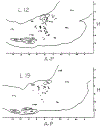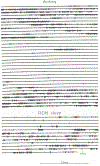Sleep and waking activity of pontine gigantocellular field neurons
- PMID: 195831
- PMCID: PMC9044355
- DOI: 10.1016/0014-4886(77)90321-1
Sleep and waking activity of pontine gigantocellular field neurons
Abstract
The sleep and waking discharge of pontine gigantocellular field’ units was studied in unrestrained cats. Three cell types were distinguished on the basis of discharge rate. Type 1 had no spontaneous activity during quiet waking and sleep, discharging only during movements. Type 2 had high rates of tonic activity during both quiet waking and sleep. Type 3 had low activity rates during quiet waking and slow-wave sleep, but discharged in bursts during both waking movements and rapid eye movement (REM) sleep. Units with augmented discharge restricted to REM sleep were not observed. All pontine gigantocellular field cells discharged rapidly during specific waking movements at rates exceeding mean REM sleep rates. Among type 2 and 3 cells, REM sleep and active waking discharge rates were correlated, with cells that discharged rapidly in REM sleep also showing high rates during active waking. Adaptation to head restraint reduced waking motor activity and the correlated pontine gigantocellular field discharge, yielding a reduced estimate of waking discharge rates. Our results are consistent with an hypothesis of pontine gigantocellular field unit involvement in the motor activation common to both waking and REM sleep, but are not consistent with an executive role for these neurons in the triggering of the REM sleep state.
Figures











Similar articles
-
Selective firing of rat pontine gigantocellular neurons during movement and REM sleep.Brain Res. 1977 Jun 3;128(1):146-52. doi: 10.1016/0006-8993(77)90242-6. Brain Res. 1977. PMID: 194653 No abstract available.
-
Activity of medullary reticular formation neurons in the unrestrained cat during waking and sleep.Brain Res. 1979 Dec 21;179(1):49-60. doi: 10.1016/0006-8993(79)90488-8. Brain Res. 1979. PMID: 228803 Free PMC article.
-
Pontine cholinergic reticular mechanisms cause state-dependent changes in the discharge of parabrachial neurons.Am J Physiol. 1994 Jan;266(1 Pt 2):R136-50. doi: 10.1152/ajpregu.1994.266.1.R136. Am J Physiol. 1994. PMID: 8304534
-
Suprapontine influences on respiratory patterning during sleep-waking states.Prog Clin Biol Res. 1990;345:33-9; discussion 40. Prog Clin Biol Res. 1990. PMID: 2198594 Review. No abstract available.
-
[Mechanisms of dream-sleep-wakefulness cycle].Rev Prat. 1996 Dec 15;46(20):2404-10. Rev Prat. 1996. PMID: 9035524 Review. French.
Cited by
-
A function for REM sleep: regulation of noradrenergic receptor sensitivity.Brain Res. 1988 Nov;472(3):213-33. doi: 10.1016/0165-0173(88)90007-0. Brain Res. 1988. PMID: 3066435 Free PMC article. Review.
-
REM sleep deprivation reduces auditory evoked inhibition of dorsolateral pontine neurons.Brain Res. 1991 Jun 28;552(2):333-7. doi: 10.1016/0006-8993(91)90100-a. Brain Res. 1991. PMID: 1913194 Free PMC article.
-
Behavioral state control through differential serotonergic inhibition in the mesopontine cholinergic nuclei: a simultaneous unit recording and microdialysis study.J Neurosci. 1998 Jul 15;18(14):5490-7. doi: 10.1523/JNEUROSCI.18-14-05490.1998. J Neurosci. 1998. PMID: 9651229 Free PMC article.
-
Relationships of nucleus reticularis pontis oralis neuronal discharge with sensory and carbachol evoked hippocampal theta rhythm.Exp Brain Res. 1991;87(2):303-8. doi: 10.1007/BF00231847. Exp Brain Res. 1991. PMID: 1769384
-
Behavioral functions of the reticular formation.Brain Res. 1979 Jul;180(1):69-105. doi: 10.1016/0165-0173(79)90017-1. Brain Res. 1979. PMID: 114277 Free PMC article.
References
-
- AMASSIAN VE, AND DEVITO RV. 1954. Unit activity in reticular formation and nearby structures. /. Neurophysiol. 17 : 575–603. - PubMed
-
- HERMAN AL 1968. The Brain Stem of the Cat. University of Wisconsin Press, Madison.
-
- EVARTS EV 1964. Temporal patterns of discharge of pyramidal tract neurons during sleep and waking in the monkey. J. Neurophysiol. 27: 152–171. - PubMed
-
- GROVES PM, MILLER SW, PARKER MV, AND REBEC GV. 1973. Organization by sensory modality in the reticular formation of the rat. Brain Res. 54: 207–224. - PubMed
-
- HARPER RM, AND JACOBS BL. 1972. Red nucleus neuronal activity during sleep and wakefulness. Sleep Res. 1 : 20.
Publication types
MeSH terms
Grants and funding
LinkOut - more resources
Full Text Sources
Miscellaneous
